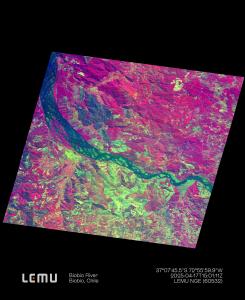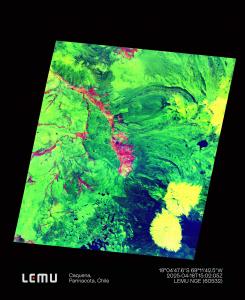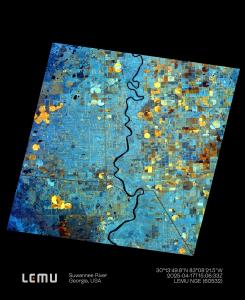Lemu Nge Delivers On Promise — Biodiversity Signals from Space Now Visible

Finding the balance between sustainable forestry and the protection of two of Chile’s most endangered native trees. Biobío River (Chile) on April 17th 2025 captured with 32 bands by Lemu Nge. © LEMU GLOBAL, LTD.
Lemu validates its orbital mission with calibrated hyperspectral data—revealing biodiversity signals and marking a new phase in space-based monitoring.
---
Key Highlights:
• First proof-of-concept validation of Lemu Nge, a hyperspectral satellite focused on biodiversity.
• Research-grade calibrated data with over 99.5% valid pixels and no anomalies.
• A step forward in closing the Nature Data Gap with high-resolution, non-invasive monitoring.
---
Launched in 2024 and led from the Chilean Patagonia, Lemu Nge is the world’s first satellite mission designed explicitly to monitor biodiversity. The hyperspectral scenes released today were all captured during April 2025, and include:
• The Biobío River, Biobío, Chile: finding the balance between sustainable forestry and the protection of two of Chile’s most endangered native trees.
• Caquena, Parinacota, Chile: identifying critical Andean wetlands in a high, dry, and extremely climate-sensitive ecosystem that are difficult to reach by ground.
• The Krishna River, Telangana, India: mapping vegetation health in one of South Asia’s most intensively cultivated and polluted regions.
• The Suwannee River, Georgia, USA: detecting ecological contrasts in one of North America’s richest and most threatened watersheds.
Captured across 32 hyperspectral bands (420–900 nm), these observations will enrich Atlas, Lemu’s Nature Intelligence Platform. Offering up to 20x greater resolution than traditional satellite systems, Lemu Nge (“Forest Eye” in Mapudungun) enables enhanced monitoring of nature-related risks and opportunities. These new data layers will strengthen Atlas indicators such as LemuRank (spatial conservation prioritisation) and Biorarity (rarity-weighted species richness). Atlas is already being used by organisations including Banco Central de Chile, Codelco, and Conexión Kimal Lo Aguirre, Latin America's longest and most powerful transmission line.
“These images are more than stunning pictures. They’re signals we couldn’t see—until now,” said Leo Prieto, CEO and Founder of Lemu. “Today we have the spatial, spectral, and temporal resolution to detect biological diversity and ecosystem complexity from space—continuously, globally, and efficiently. It’s a step change in our ability to understand and protect nature, and along the way, it proves that small, distributed, and collaborative teams can lead with pioneering solutions to the world’s biggest challenges.”
---
Scientific Validation of a Global Mission
---
Originally conceived as an R&D mission, Lemu Nge was built to test compact hyperspectral sensors for detecting biodiversity signals from space. With this release, the mission has achieved proof-of-concept validation, generating research-grade data ready to support ecological science and policy.
The current outputs are calibrated at Level 1 (top-of-atmosphere radiance). Level 2 atmospheric correction is scheduled later this year, enabling surface reflectance and deeper ecological modelling. Even at this stage, the data supports the calculation of spectral diversity indices, a key proxy for ecological complexity.
“These results bring us closer to understanding the state of ecosystems and how they are changing,” said Francisco Galdames, Senior Data Scientist at Lemu. “We’re not yet identifying individual species, that’s our next goal, but we’re detecting spectral signatures that reflect ecological heterogeneity—crucial for modelling ecosystem health and variation. Having data of this quality now is vital. It allows us to start documenting change, raise awareness, and inform decisions that help reverse the environmental crisis.”
“Each image represents a precision effort by a global team,” added Franco Magni, Remote Sensing Scientist at Lemu. “From orbital design to calibration, this was a complex collaboration. Lemu Nge is a milestone in space-based biodiversity science—led from Chile, enabled by outstanding partners and people.”
---
From the Nature Data Gap to Nature Intelligence
---
Biodiversity is essential to every economy, yet remains largely invisible to decisions. Until now, monitoring has lacked the resolution, consistency, and scale needed to make nature measurable. Lemu Nge changes that.
Unlike general-purpose Earth observation missions, Lemu Nge was purpose-built to close the Nature Data Gap. Its data is uniquely suited to ecological monitoring, powering applications across science, regulation, and nature-positive operations.
The hyperspectral scenes released today were unveiled at the Earth Observation (EO) Summit 2025, where Lemu was the only biodiversity-focused mission invited to present. Sharing the stage with global leaders in aerospace and environmental policy, Lemu Nge stood out for its focus on Nature, Latin American leadership, and operational proof.
This milestone is the latest in a series of firsts since Lemu Nge launched into orbit on August 16, 2024. Just four days later, the mission captured first light with a flawless acquisition. Within 12 days, the first RGB image was processed. By the end of 2024, the team had produced the first hyperspectral image with preliminary geometric and radiometric calibration. With this latest achievement, Lemu continues its campaign to make biodiversity visible, measurable, and actionable at scale.
---
About Lemu
---
Lemu is Latin America’s leading Nature Tech company, making nature visible in every decision. We launched Lemu Nge, the world’s first biodiversity-focused hyperspectral satellite, and Atlas, our Nature Intelligence platform that transforms complex environmental data into clear, actionable insight. Powered by our proprietary Spacetime 4D nature data protocol and Gaia AI models, Atlas helps companies, governments, and communities understand their impact and dependence on nature. By combining AI, satellite data, and ecological science, we bring Nature Intelligence to Business Intelligence—helping protect the living systems we all depend on.
--- --- ---
Visit Lemu: https://le.mu
--- --- ---
Paulo Paredes
Lemu Global Ltd
hello@le.mu
Legal Disclaimer:
EIN Presswire provides this news content "as is" without warranty of any kind. We do not accept any responsibility or liability for the accuracy, content, images, videos, licenses, completeness, legality, or reliability of the information contained in this article. If you have any complaints or copyright issues related to this article, kindly contact the author above.
Helvetic Clinics bestätigt europäische Marktführerschaft im Zahntourismus mit 20 % Wachstum im ersten Halbjahr 2025
Technical Review: leagend BA2001 Battery Tester for Lead-Acid and LiFePO₄ Batteries
Medical Supplierz Expands Services to Support Bulk Clinic Procurement
Więcej ważnych informacji
 Jedynka Newserii
Jedynka Newserii

 Jedynka Newserii
Jedynka Newserii

Bankowość

Rośnie liczba i wartość udzielonych konsumentom kredytów gotówkowych. Gorzej mają się kredyty ratalne oraz te udzielane firmom
Rynek kredytowy w Polsce co do zasady rośnie, choć nierównomiernie. Z danych Biura Informacji Kredytowej wynika, że najlepiej rozwija się segment kredytów gotówkowych dla konsumentów. Wartościowo wzrosła też kwota udzielonych limitów w kartach kredytowych. Według prognoz BIK w całym roku wzrośnie wartość zarówno udzielonych kredytów mieszkaniowych, jak i gotówkowych, choć tych pierwszych poniżej inflacji. Wcześniejsze cięcia stóp procentowych przez RPP nie zmieniły tej prognozy.
Transport
37,5 proc. środków z Planu Społeczno-Klimatycznego trafi na walkę z ubóstwem transportowym. Organizacje branżowe apelują o zmianę priorytetowych projektów [DEPESZA]

Ministerstwo Funduszy i Polityki Regionalnej z końcem czerwca zakończyło konsultacje Planu Społeczno-Klimatycznego, który otwiera drogę do pozyskania 65 mld zł (11,4 mld euro) z unijnego Społecznego Funduszu Klimatycznego. Polska będzie jego największym beneficjentem, a 37,5 proc. budżetu zostanie przeznaczone na bezpośrednie wsparcie osób narażonych na ubóstwo transportowe. Organizacje branżowe oceniają jednak, że walka z tym zjawiskiem może się okazać nieskuteczna. W toku konsultacji zgłosiły swoje zastrzeżenia co do priorytetów w wydatkach i sposobu wsparcia inwestycji w transport rowerowy.
Prawo
Firmy będą mogły przetestować krótszy tydzień pracy z rządowym wsparciem. Nabór wniosków ruszy w sierpniu

Ministerstwo Rodziny, Pracy i Polityki Społecznej uruchamia pilotaż krótszego tygodnia pracy. Zainteresowane wzięciem w nim udziału firmy będą się mogły ubiegać o wsparcie finansowe ze strony rządu. Politycy Nowej Lewicy, którzy są pomysłodawcami testu tego rozwiązania, przekonują, że finalnie zyskają na nim wszyscy, zarówno pracownicy, jak i pracodawcy, a ostrzeżenia o spodziewanych problemach gospodarki są mocno przesadzone.
Partner serwisu
Szkolenia

Akademia Newserii
Akademia Newserii to projekt, w ramach którego najlepsi polscy dziennikarze biznesowi, giełdowi oraz lifestylowi, a także szkoleniowcy z wieloletnim doświadczeniem dzielą się swoją wiedzą nt. pracy z mediami.


![37,5 proc. środków z Planu Społeczno-Klimatycznego trafi na walkę z ubóstwem transportowym. Organizacje branżowe apelują o zmianę priorytetowych projektów [DEPESZA]](https://www.newseria.pl/files/1097841585/rower3,w_85,_small.jpg)







.gif)

 |
| |
| |
|